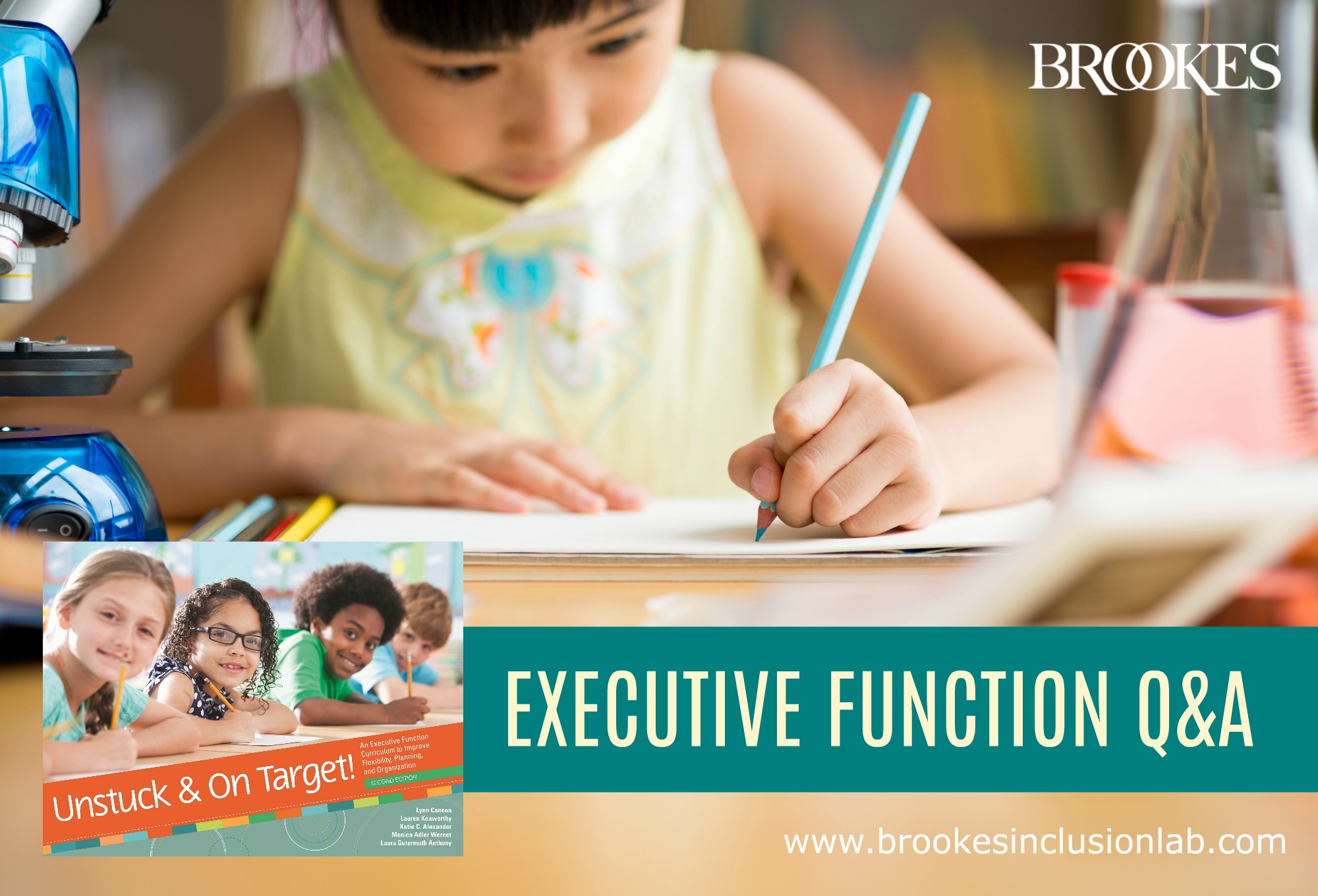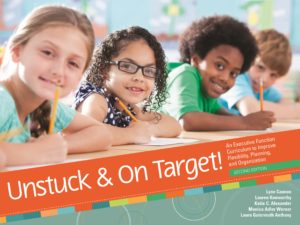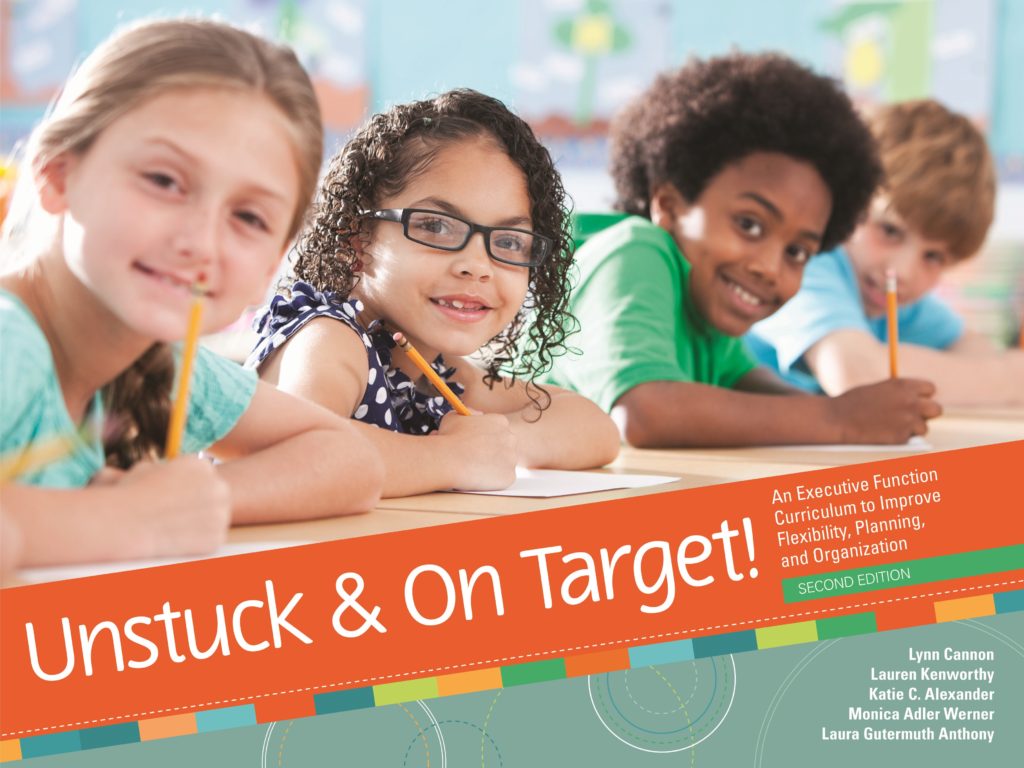How to Get Students Unstuck & On Target: An Executive Function Q&A
September 18, 2018
 Executive function is one of our most popular topics here on the Inclusion Lab—we know our readers are always on the lookout for more tips, insights, and resources on helping their students improve these critical skills. So today we’re bringing you a great Q&A with Monica Adler Werner, Parent and Executive Function Coach at the Center for Autism Assessment and Treatment. Monica is a coauthor of the new edition of Unstuck & On Target!—a curriculum that helps explicitly teach executive function skills like flexibility and goal-setting to learners with autism, ADHD, and other challenges.
Executive function is one of our most popular topics here on the Inclusion Lab—we know our readers are always on the lookout for more tips, insights, and resources on helping their students improve these critical skills. So today we’re bringing you a great Q&A with Monica Adler Werner, Parent and Executive Function Coach at the Center for Autism Assessment and Treatment. Monica is a coauthor of the new edition of Unstuck & On Target!—a curriculum that helps explicitly teach executive function skills like flexibility and goal-setting to learners with autism, ADHD, and other challenges.
In this interview, Monica talks about the importance of flexibility, introduces the steps of the Unstuck approach, and talks about how busy teachers can make Unstuck a part of their day to day classroom routine.
Q1. Unstuck & On Target! is a curriculum focused on helping students who have executive function challenges. For teachers who might have limited experience recognizing executive function issues—what might they look like in a classroom? What kinds of behaviors and struggles might you see in a student who could benefit from your curriculum?
Some students are often called inattentive, inconsiderate, disorganized, and unmotivated. They are the students who are “really smart” but just “seem like they won’t do anything they don’t like.” We hear a lot of “won’t’s” and “should be able to’s” about the students Unstuck targets. We also hear a lot about students who are really rigid or “stuck.” Once they get an idea, they won’t flex, and they will persist down their path heedless of the consequences.
Students may be having meltdowns, disrupting class, refusing to do work, or rushing through the work. Others may be quietly withdrawn and doing the bare minimum. They are often highly verbal and intellectually engaged, and can tell you all the right things to do. But when they have to do those same things, they don’t. That’s a hallmark of executive function difficulties, what H.L. Teuber once called the “curious disassociation between knowing and doing.”
Teachers are often very frustrated because they have tried countless approaches, taught and retaught, put in point systems, called parents, and yet there is still no progress. And that’s how Unstuck started, with teachers and psychologists working together to try a different approach, one that was brain based, student centered, and teacher friendly. That’s why teachers like Unstuck so much; it works and is doable!
Q2. Boosting cognitive flexibility is one of the central goals of your curriculum. Why is flexibility so important to success in school, and can you give teachers some practical tips on how to encourage flexibility in their students?
Flexibility is so important to be a good problem solver and find success. If we are rigid, we live in the black-and-white binary world. Everything becomes a high-stakes endeavor, with success or failure as absolutes. But with flexibility comes the ability to appreciate and live in the grey area, to learn from mistakes and solve problems and move ahead.
Teachers and parents see this all the time. A child becomes stuck and then loses everything. They have a meltdown because they’re disappointed (what they expected to happen didn’t happen) and then they feel terrible not just about what didn’t happen the way they expected but about the fuss and dislocation they caused to others. This kind of vicious cycle is so terrible for everyone. So we teach children that in fact they are more flexible than they realize and how to be flexible. We catch the child in the act of being flexible and notice how they made a Plan B: that’s Unstuck! Now you’ve given the child a starting point for success, they’ve experienced the power of the Plan B, and everyone is celebrating.
How does that look in school? Say the child comes into class and forgets their homework folder. The teacher smiles at them when they come back in with the folder, even after they were reminded, and says, “you were so flexible! We made a Plan B to go back to your locker. What a great way to start the day!”
Q3. You have an overarching strategy called Goal-Why-Plan-Do-Check that you use as a framework for the lessons in your curriculum. Can you explain the five steps of this process and why it’s an effective way to support students?
Goal, Why, Plan, Do, Check (GWPDC) is central to the Unstuck intervention and is the system, or formula, that we can all use to solve problems. The starting point is to get real clarity on the goal. Often students say they have one goal—e.g., “play with Timmy at recess”—when in fact there is a larger goal they have at recess, e.g. “have fun and play at recess.” Playing with Timmy can be a Plan A to achieve that fun and play goal, but there are usually many other plans that will help them reach that goal.
Most students won’t struggle with the “why” in the recess scenario, but they do often struggle with this step when it comes to nonpreferred work in school or at home. A student who constantly balks at math and refuses to do the worksheets can really benefit from the teacher and student using GWPDC to figure out how to get the student engaged in their math learning. The “why” is often very abstract for students or too remote or even dictatorial (“because that’s the way it is!”). So working with a child to help them find a “why” that is meaningful to them is really important. And that “why” may end up being pretty simple: so that I can finish and get to a more preferred activity. Teachers and parents should share their why’s, too, but remember: we do things for our own reasons, not other peoples’.
The idea of making a plan in advance is the third part of the Unstuck approach. Students often have a plan that is not working for them, but don’t recognize it as a plan. By first looking at the fact that they already made a plan (even without knowing) and then encouraging them to do and check the plan. we are encouraging self-reflection and course correcting. So after a plan has been executed, students reflect on whether the plan worked; if not, there’s always a Plan B. It’s important that students recognize that the problem is not them, it’s the plan. It helps students understand that success comes from systematically trying and when something doesn’t work, looking at where the problem was in the plan and making a new one. That’s how we really help students learn to problem solve and persist in the face of obstacles.
Q4. A big part of ensuring the success of interventions is keeping the home-school connection strong. How can teachers get parents more involved in strengthening their child’s executive function skills?
Unstuck makes the home/school connection easy. Every lesson has a “home extension” that summarizes what the student learned and gives ideas for how the parents can use the ideas at home. Parents love these handouts as they give parents concrete ideas for how to use the strategies that their children are learning, which leads to more positive interactions with their children.
Q5. As you mention in Unstuck, it’s important for teachers themselves to be flexible, organized, and supportive if they want to encourage those qualities in their students. What are some specific steps a teacher could take to improve in those areas?
Teachers have so much on their minds these days. But we always start by reminding teachers that the students who most need Unstuck are usually already taking a lot of time and energy. What Unstuck does is allows teachers to be more effective in their work with their students—the whole reason we went into education in the first place!
Teachers can use the Unstuck strategies to think about their own flexibility and plans. Using the GWPDC approach on ourselves as educators can help us reflect on what’s going wrong in our interactions: Do we have different goals from the child? Do we have Plan As (that while beautiful) are not working for the child? A teacher can help just by narrating their confusion: “I think I have the wrong plan here, but feel a little stuck. I’m going to take a break to think of a Plan B.”
Teachers already have so many of the tools that Unstuck recommends, but often forget to use them. To that end, we remind them of some basic strategies: create routines, write things down—we love small whiteboards for communicating with students—and be a good coach by breaking things down, practicing and then practicing some more.
Specifically, teachers should try to the following:
- Have clear, checklist-format lists for repeated routines, especially transitions, arrival, and dismissal.
- Have small whiteboards easily available. When a student is overloaded, write a short note, maybe even with a yes/no box. For example, “Please do 3 problems and then check in with me. If they are too hard, see me sooner.”
- Make it a collaborative process. Think about where a student struggles the most and find a quiet time to do a GWPDC with them.
- Make the implicit explicit. Don’t assume the student knows the why or even the how just because they have done it before or you have told them before.
- Focus on success. Praise students five times for every time you make a correction or demand. That is going to change teacher behavior a lot: it forces us to really decide what is important.
- Use the scripts whenever possible and narrate your experience. You might say, “I had a great plan to make marshmallow sculptures today, but my daughter got sick and I ran out of time to buy marshmallows. We will have to make a Plan B!”
Q6. What would you say to a busy teacher who knows her students need executive function support but is worried about the time it might take to incorporate a new curriculum? How does Unstuck fit in with what the teacher is already doing?
Unstuck is a reallocation of time: Teachers are substituting the time they spend in frustrating, nonproductive crisis management with teaching and scaffolding for success. The idea is to not add too much in, but rather become aware of how you can incorporate Unstuck in your day to day practice. So “students will be able to (SWBAT) or Objective” becomes “goal” on the board. “Plan” is what the work will be. “Check” comes in at the end of class when the teacher quickly reviews how he lesson went or does an exit ticket. Some teachers just put GWPDC on their whiteboards and fill it in for each class!
The real power of Unstuck comes from the incorporation of the strategies in day to day life. You know you’re there when you ask the customer service representative on the phone if they can help you make a Plan B. Then you’ve truly embraced the Unstuck scripts and approach!
Q7. Can you tell us a little about one of your favorite Unstuck & On Target! lessons—maybe one that teachers tell you they especially love?
I think my favorite lesson is the story of Silly Putty. It’s such a compelling story of invention and failure—-and how looking at an unintended consequence flexibly can lead to wonderful things. My other favorite is the obstacle course. Students run an obstacle course first with their bodies completely rigid, and then they run the course being allowed to be normally flexible. We compare the two experiences, both in terms of time and experience. This kind of kinesthetic learning is so powerful and salient—and fun!
Thanks so much to Monica for taking the time to answer these questions! To learn more about the multicomponent Unstuck & On Target! kit, just follow the link below—you’ll find reviews, the TOC, an excerpt and sample activity, and more.
A School-Based Curriculum to Support Executive Functioning Skills, Second Edition
By Lynn Cannon, M.Ed.; Lauren Kenworthy, Ph.D.; Katie C. Alexander, M.S., OTR/L; Monica Adler Werner, M.A.; and Laura Gutermuth Anthony, Ph.D.





Write a Comment
Your email address will not be published. Required fields are marked *
Post a Comment